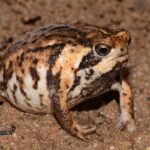- Introduction: Small Wonders of Brazil's Atlantic Forest
- Taxonomy and Classification
- The Natural Habitat: Life on the Forest Floor
- Physical Characteristics: Expertly Camouflaged
- Behavior and Life Cycle: Unique Reproductive Adaptations
- Ecological Role: Tiny Frogs with Big Impact
- Threats and Conservation Status: A Species at Risk
- Cultural and Scientific Significance: Guardians of Ancient Heritage
- Conclusion: Preserving the Delicate Balance of the Forest Floor
Introduction: Small Wonders of Brazil’s Atlantic Forest#
Beneath the dense, emerald-green canopy of Brazil’s Atlantic Forest—a biodiversity hotspot brimming with extraordinary wildlife—lies a creature as fascinating as it is elusive: the Ischnocnema sambaqui frog. Scientifically known as Ischnocnema sambaqui, this diminutive amphibian is often missed by casual visitors dashing past towering trees and lush foliage. Yet, hidden amidst layers of leaf litter, its story epitomizes the wonder and fragility of tropical ecosystems.
Named after “sambaqui,” meaning ancient shell mounds left by indigenous peoples along coastal areas, Ischnocnema sambaqui embodies a quiet reminder of the intricate bond between natural and cultural histories. Though barely exceeding a few centimeters in length, this small, earth-hued frog offers enormous insights into environmental health, evolutionary adaptation, and conservation dynamics in one of the world’s most threatened habitats.
Taxonomy and Classification#
The sambaqui frog belongs to the family Brachycephalidae, within the order Anura—the group encompassing the world’s diverse frogs and toads. Specifically nested inside the genus Ischnocnema, it shares close kinship with other terrestrial frogs characterized by direct development: a fascinating reproductive adaptation where frogs bypass a free-living tadpole stage entirely, emerging from eggs directly as miniature versions of the adults.
Within its genus, Ischnocnema sambaqui is closely related to species such as Ischnocnema parva and Ischnocnema henselii, distinguished by fine genetic and morphological features found through careful herpetological studies.
The Natural Habitat: Life on the Forest Floor#
Endemic to the lush coastal forests of southeastern Brazil, Ischnocnema sambaqui predominantly thrives in the Atlantic Forest’s dense understory. This biome, sadly experiencing ongoing fragmentation and habitat loss, remains one of Earth’s most critical regions for conservation priority.
These frogs prefer moist microhabitats, typically nestled among fallen, decomposing leaves and branches—a habitat known as leaf litter. Warm, damp, and shielded from predators and environmental extremes, leaf litter provides an ideal environment for these small amphibians to feed, shelter, and reproduce. Here, hidden beneath the vibrant foliage, they quietly navigate their small world, well-adapted to the rhythmic ebb and flow of rainfall, sunlight, and predation.
The sambaqui frog’s specialized microhabitat selection emphasizes the intricate ecological balance of tropical forests. Its presence in a habitat is considered an indicator of ecosystem health, as it requires pristine forest habitats relatively undisturbed by human influence.
Physical Characteristics: Expertly Camouflaged#
Despite its comparatively small size—adults rarely surpassing two to three centimeters—Ischnocnema sambaqui exhibits traits finely tuned to survival within its specialized environment. They possess sturdy, terrestrial bodies, short limbs designed for steady movements through leaf litter, and large eyes sensitive to subtle movements that help them evade predators and capture their own prey.
Their coloration largely consists of earthy shades: varying shades of brown, olive-green, or gray, often mottled with intricate, subtle patterns mimicking the texture and colors of fallen leaves. This color scheme ensures superb camouflage within the leaf-litter microhabitat, blending seamlessly into the forest floor. It is a remarkable evolutionary adaptation, enhancing survival rates by protecting these frogs from keen-eyed predators such as birds, snakes, and small mammals.
An intriguing physical characteristic of this species is its rough, granular skin texture, providing physical reinforcement against threats and injuries. Additionally, their fingertips often bear small pads, somewhat adhesive, enabling them to delicately anchor themselves onto damp leaves and stems as they move through their habitat.
Behavior and Life Cycle: Unique Reproductive Adaptations#
Unlike many frog species that famously undergo an aquatic tadpole stage, sambaqui frogs have evolved direct development. Females lay eggs under moist leaf litter, carefully hidden beneath leaves or within the crevices of logs and decaying wood. Rather than developing into free-swimming larvae, embryos directly become fully formed miniature frogs—complete with fully functioning limbs and respiratory systems.
This fascinating life cycle significantly reduces reliance on freshwater sources for breeding. Direct development allows sambaqui frogs to inhabit forests without ample, stable water bodies—a huge advantage in regions where dry seasons may limit reliable water sources.
The behavior of individuals is largely nocturnal and secretive. By day, they remain concealed beneath leaves or logs, preserving moisture and energy. By night, they emerge to hunt relentlessly for small invertebrate prey, including ants, beetles, and tiny arthropods scuttling among the fallen leaves.
Regarding communication, the male Ischnocnema sambaqui possess distinct vocalizations—soft chirps or clicks—to attract potential mates or to assert territorial claims. These subtle, unobtrusive songs create a nightly chorus along the forest floor, scarcely noticeable to the unaware ear but incredibly significant within their concealed communities.
Ecological Role: Tiny Frogs with Big Impact#
Despite their modest size and secretive habits, sambaqui frogs play essential ecological roles within the delicate tapestry of biodiversity that constitutes Brazil’s coastal forests. Acting as both predator and prey, their presence influences a healthy balance of insect populations. By controlling populations of small invertebrates, these frogs help maintain ecological balance and safeguard the forest ecosystem’s overall integrity.
Additionally, sambaqui frogs act as important prey for numerous larger animals, including snakes, birds, and small mammals. Their abundance or decline directly affects this broader food web, making their population health a reliable indicator of the general health and sustainability of the ecosystem around them.
Threats and Conservation Status: A Species at Risk#
As inhabitants of Brazil’s increasingly fragmented coastal forests, Ischnocnema sambaqui faces significant conservation challenges. Habitat destruction and fragmentation due primarily to urban expansion, agricultural land clearance, and logging remain the most direct threats to their populations. Climate change further complicates matters, altering rainfall patterns, humidity levels, and temperature ranges—all factors directly impacting these sensitive amphibians.
The International Union for Conservation of Nature (IUCN) has classified the Ischnocnema sambaqui as Data Deficient (DD), mainly due to limited detailed population studies. This lack of data underlines the necessity for increased research and monitoring. Effective conservation strategies depend critically on accurate and comprehensive scientific studies detailing local populations, biology, and ecological interactions.
Currently, the main method of conservation relies upon protecting the large patches of remaining Atlantic Forest habitat via protected parks, reserves, and conservation corridors. Environmental education initiatives also help local communities recognize the unique value and vulnerability of creatures like sambaqui frogs, promoting coexistence, appreciation, and proactive conservation efforts.
Cultural and Scientific Significance: Guardians of Ancient Heritage#
The sambaqui frog, drawing its intriguing name from the cultural heritage of pre-colonial coastal people, possesses a symbolic value linking Brazil’s natural and human histories. Though subtle and scarcely noticed, it serves as a living link between the region’s ecological diversity and its human cultural heritage, highlighting the timeless bond between nature and people.
From a scientific perspective, frogs like Ischnocnema sambaqui are critical to our understanding of ecological connections, evolutionary biology, and climate change effects on tropical ecosystems. Their adaptation to leaf litter habitats and direct-developing reproductive strategies offer evolutionary insights into how amphibians adapt to complex terrestrial environments.
Conclusion: Preserving the Delicate Balance of the Forest Floor#
Amid the vibrant and diverse tapestry of Brazil’s Atlantic Forest, the peculiar yet captivating Ischnocnema sambaqui frog plays a crucial role. To protect species like the sambaqui frog is to safeguard the intricate ecological systems that sustain biodiversity, climate stability, and even cultural integrity.
By learning about and raising awareness of species such as Ischnocnema sambaqui, each of us can play a small yet vital part in global biodiversity conservation. Exploring deeper, supporting conservation initiatives, or encouraging habitat protection all represent essential actions that can turn admiration for this tiny rainforest inhabitant into meaningful preservation.







